FHRS Display Audit 2022 - Mandatory display
This chapter begins by exploring awareness and attitudes towards the mandatory display of food hygiene ratings in Northern Ireland and Wales. It then covers the views which food businesses in England have towards the idea of mandatory display. The chapter concludes with findings around attitudes towards compulsory display online.
In Northern Ireland and Wales, food businesses are legally required to display their food hygiene rating sticker in a prominent place, for example at the entrance to their premises. In England, businesses are not legally required to display their rating but are encouraged to do so.
Awareness and attitudes in Northern Ireland and Wales
Most food businesses in Northern Ireland (95%) and Wales (96%) that were aware of their FHRS rating reported being aware of the legal requirement to have their food hygiene rating on display, in line with previous years. In Northern Ireland, accommodation businesses and pubs, bars and nightclubs were less likely than average to be aware of mandatory display (89%).
As illustrated in Figure 6.1, around nine in ten businesses in Northern Ireland (91%) and Wales (89%) felt that the legal requirement to display their food hygiene rating is a good thing, and most believed it is 'very good’ (Northern Ireland: 66%; Wales: 71%). The proportion of businesses in Wales that considered mandatory display to be a good thing was broadly in line with previous years. The proportion in Northern Ireland has remained identical since 2019.
Figure 6.1 Positive attitudes towards mandatory display requirements in Northern Ireland and Wales
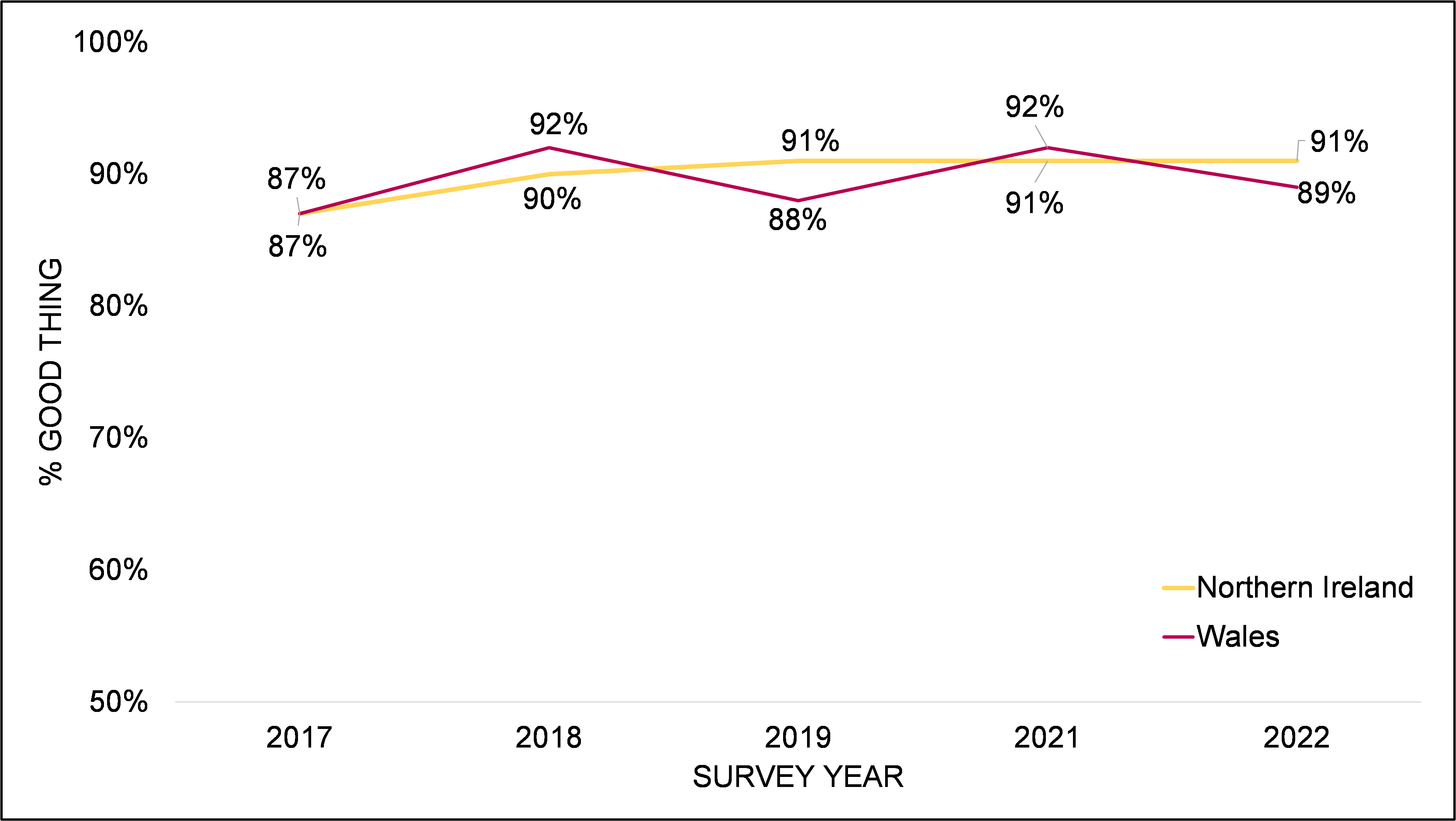
C12. How do you feel generally about the legal requirement to display your Food Hygiene Rating at your premises? Base: FBOs in Wales/NI aware of their FHRS rating (Northern Ireland: 487, Wales: 478).
In both countries, there was evidence of attitudes towards mandatory display varying by sector. In Northern Ireland, takeaways and sandwich shops were more likely than average to consider mandatory display a good thing (97%). Meanwhile, in Wales, accommodation businesses and pubs, bars and nightclubs were less likely than average to consider mandatory display a good thing (84%).
Positive attitudes towards mandatory display typically centred around the theme of transparency to customers of hygiene standards and business promotion. Specifically, as presented in Figure 6.2, the top three reasons were the view that it is important to be transparent about food hygiene (Northern Ireland 38%; Wales 35%), to demonstrate high standards to consumers (Northern Ireland 28%; Wales 28%) and the view that it helps drive businesses to maintain high standards (Northern Ireland 21%; Wales 21%).
Figure 6.2 Reasons for positive attitudes towards mandatory display in Northern Ireland and Wales (Unprompted)
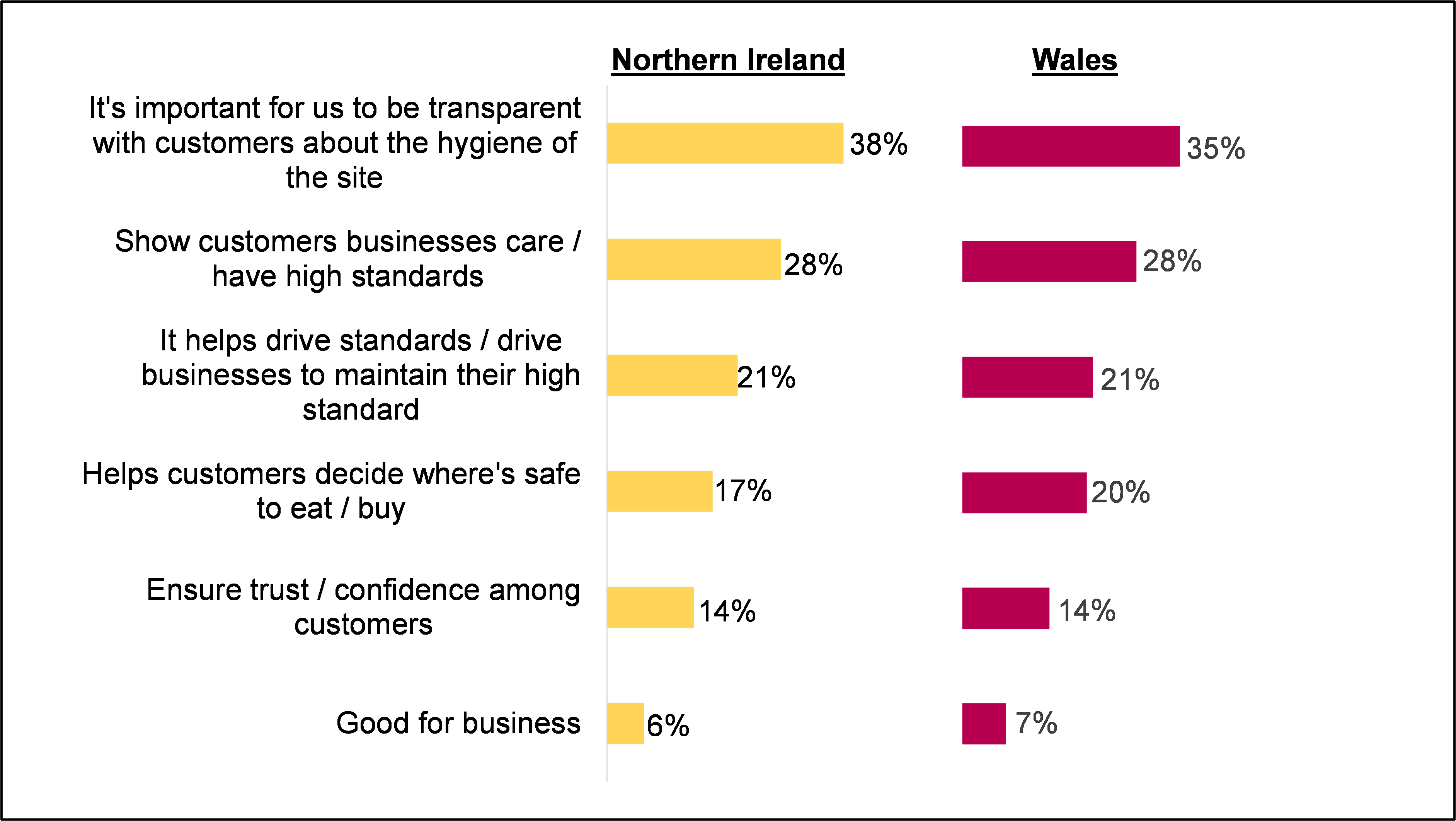
Northern Ireland: It's important for us to be transparent with customers about the hygiene of the site 38%, Show customers businesses care / have high standards 28%, It helps drive standards / drive businesses to maintain their high standard 21%, Helps customers decide where's safe to eat / buy 17%, Ensure trust / confidence among customers 14%, Good for business 6%. Wales: It's important for us to be transparent with customers about the hygiene of the site 35%, Show customers businesses care / have high standards 28%, It helps drive standards / drive businesses maintain their high standard 21%, Helps customers decide where's safe to eat / buy 20%, Ensure trust / confidence among customers 14%, Good for business 7%.
C12A. Why do you feel good about the legal requirement to display your Food Hygiene Rating at your premises? Base: FBOs that think it is good thing that it is a legal requirement to display FHRS in Wales/NI (Northern Ireland: 441, Wales: 424). Please note that responses under 6% have not been displayed.
Amongst the minority of businesses in Northern Ireland and Wales that were neutral or had negative perceptions of mandatory display, this was typically attributed to reservations around the efficacy and fairness of the FHRS:
- in Northern Ireland, of the 40 businesses that did not think mandatory display was good, 13 said that displaying the rating made no difference to their business and 8 felt there were flaws in how ratings are determined.
- similarly, in Wales, of the 50 businesses that did not think mandatory display was good, 13 said that displaying the rating made no difference to their business and 17 felt there were flaws in the way ratings are determined.
Attitudes in England
As presented in Figure 6.3, more than four in five businesses in England (82%) agreed that the introduction of a scheme where they are required by law to display their food hygiene rating was a good idea, with most (61%) considering it to be a ‘very good’ concept. Businesses with a rating of 5 were more likely to have a positive view on the introduction of such a scheme (84%), while those with a rating of 3 or less were less likely (68%). The proportion of businesses in England supporting mandatory display seems to have dipped slightly since 2021 but this difference is not statistically significant.
Figure 6.3 Positive attitudes towards mandatory display in England
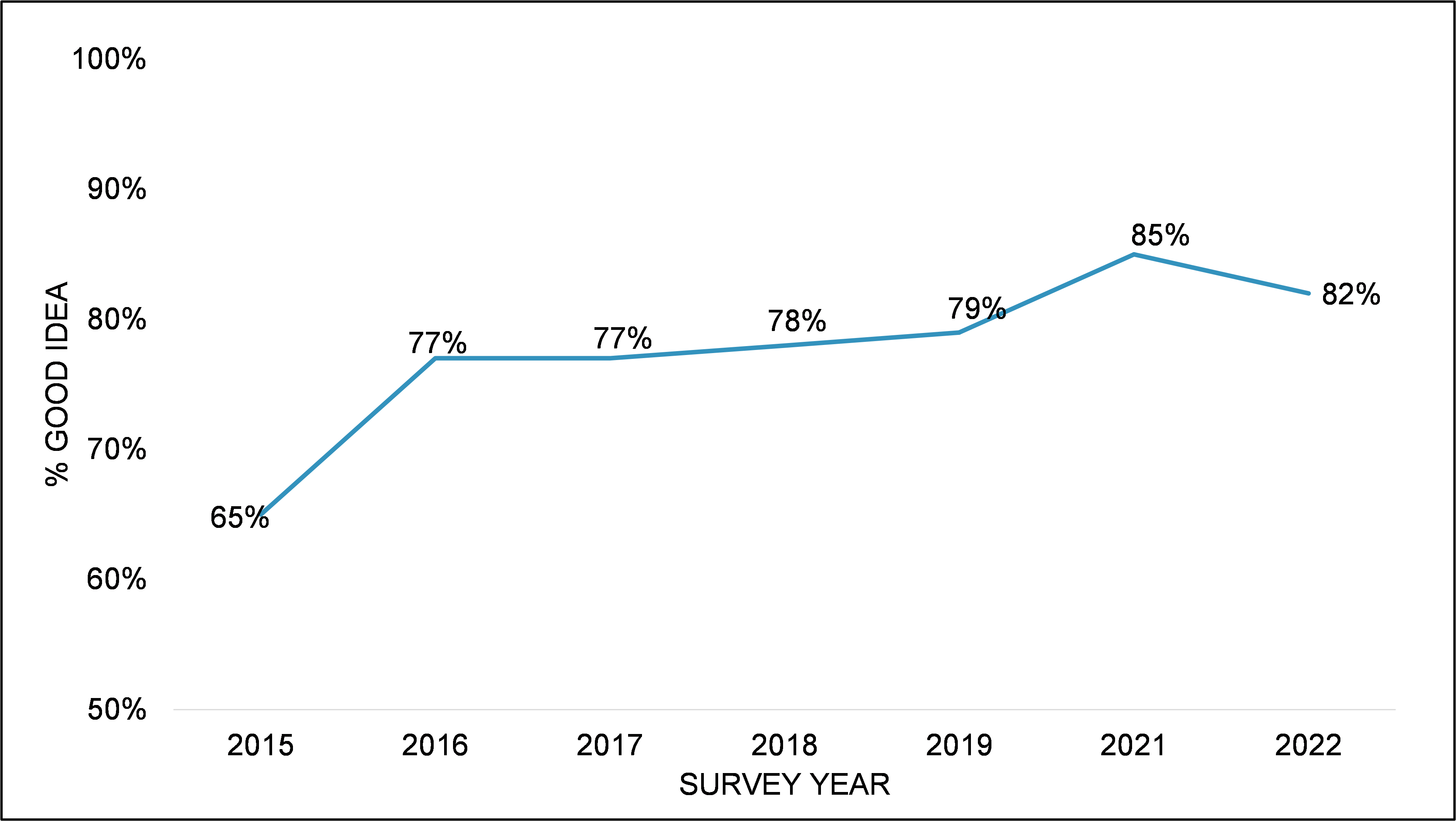
C9. How would you feel if a scheme was introduced where you were required by law to display your Food Hygiene Rating? Base: FBOs in England (465).
Amongst the food businesses in England that had positive views on the introduction of mandatory display, the most common reason was the view that it is important to be transparent about food hygiene (33%). This was also the most common reason in Northern Ireland and Wales. As presented in Figure 6.4, other reasons included helping customers make informed decisions about where is safe to purchase food (21%) and the view that it drives businesses to maintain or improve standards (20%).
"If you don’t display [a rating] it’s misleading. It’s important for transparency; communicating with your customer and giving them the opportunity to ask questions. If fully informed, customers can make a decision.”
Restaurants and catering, England, FHRS rating of 5
“It gives consumers confidence in terms of whether a premises is of a standard they require it to be. It also imposes pressure on business owners to have high standards.”
Retail, England, FHRS rating of 5
“Customers look at ratings, so if a business got anything under a 5 or 4 it would prompt you to improve the standards and procedures to improve the rating.”
Restaurants and catering, England, FHRS rating of 5
Figure 6.4 Reasons for positive attitudes towards mandatory display in England (Unprompted)
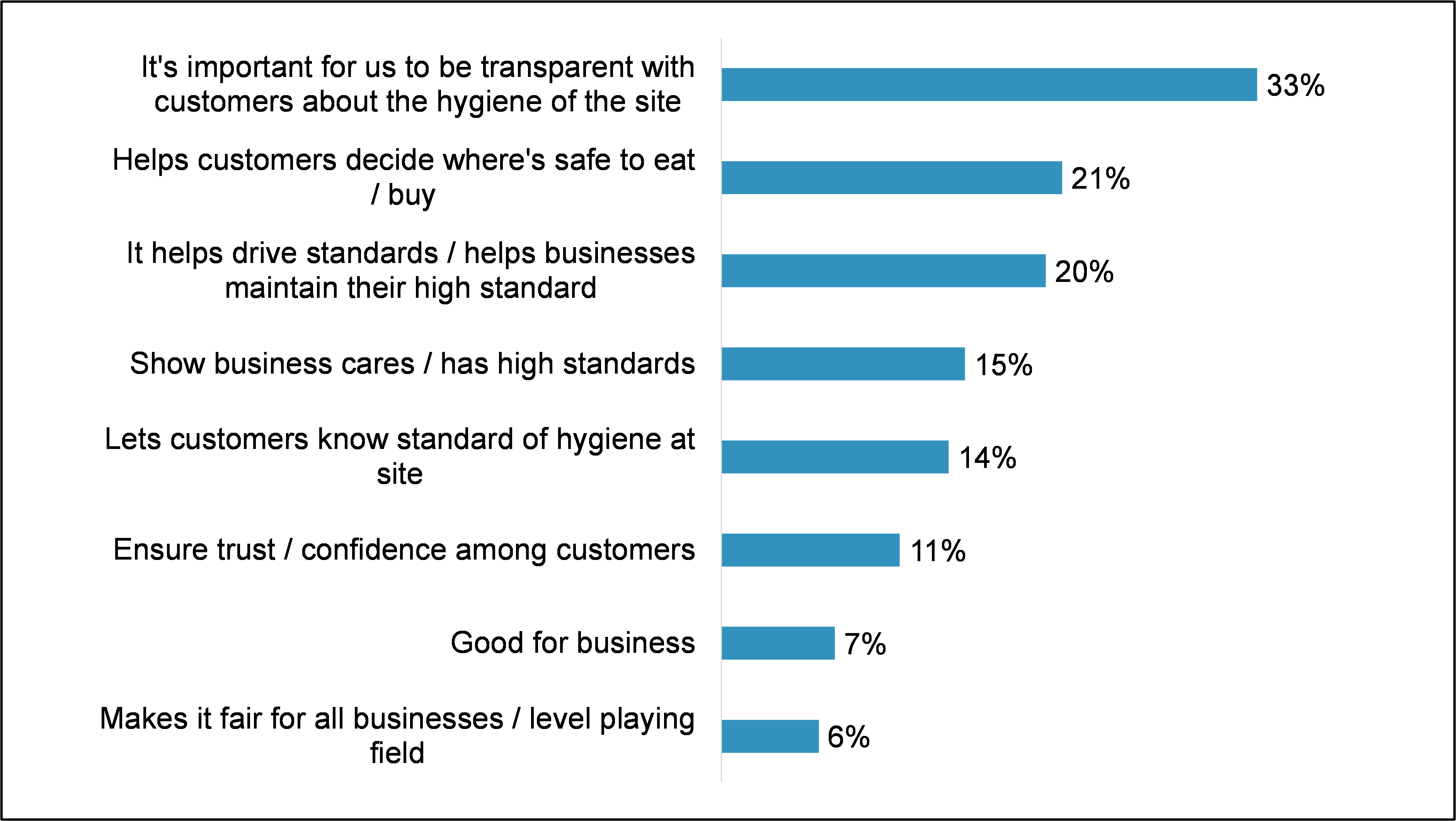
C10B. Why do you say it would be a good thing? Base: FBOs that think it would be a good thing if it was a legal requirement to display FHRS in England (380). Please note this was an open-ended question. Please note that responses under 6% have not been displayed.
As presented in Figure 6.5, amongst food businesses in England that were neutral or had negative perceptions towards the concept of mandatory display, the most common reason for this was because the business already displayed their food hygiene rating and so the introduction of a legal requirement would make no difference to the business (27%). Other reasons included the view that it would be unfair to some businesses (19%) and because of perceived flaws in the way businesses are rated (18%).
Figure 6.5 Reasons given by those businesses reporting negative attitudes towards mandatory display of FHRS ratings in England
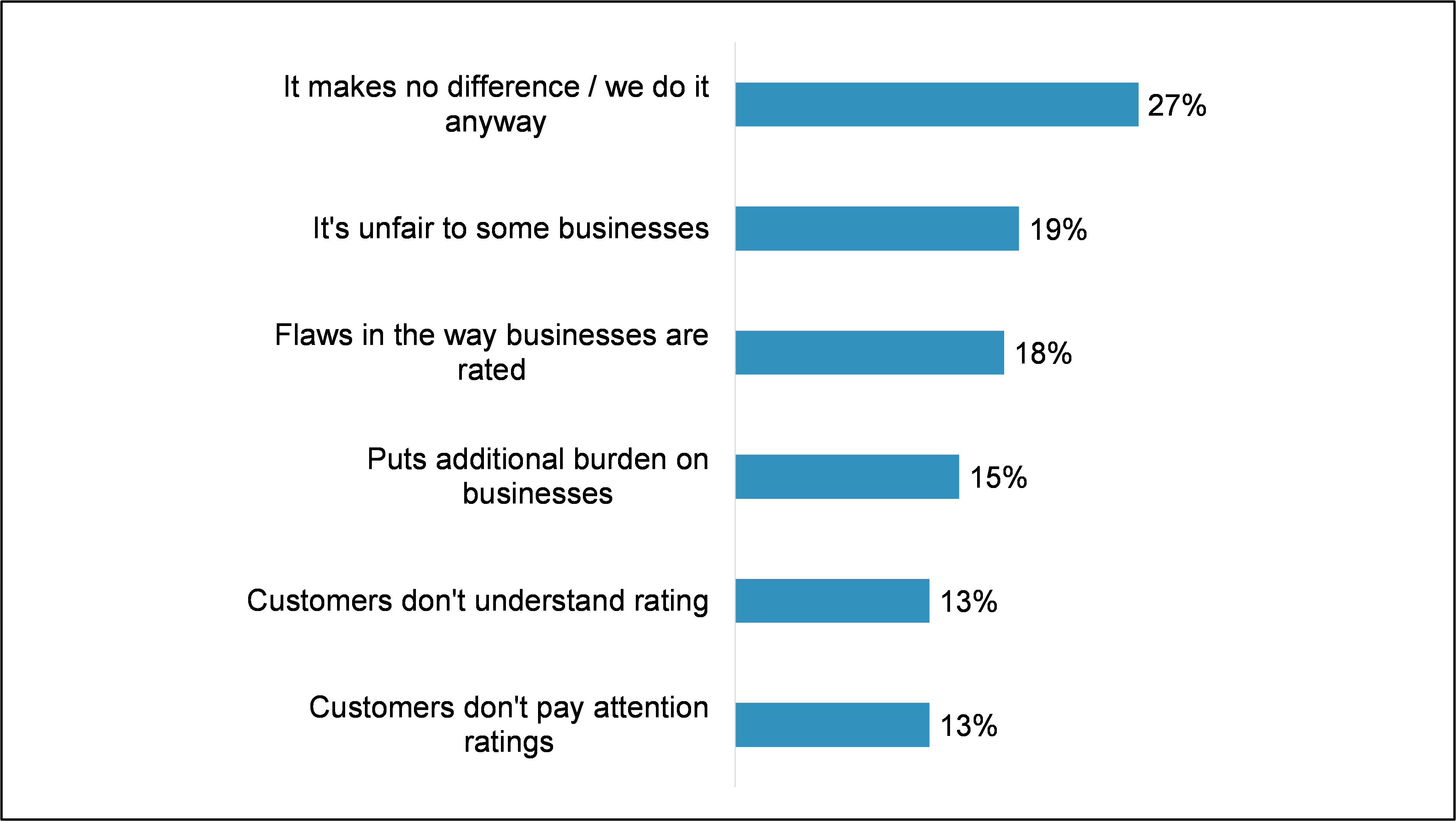
C10A. Why do you say it would be a bad thing? Base: FBOs that think it would not be a good thing if it was a legal requirement to display FHRS in England (80). Please note that responses under 10% have not been displayed.
Attitudes towards mandatory display online
In addition to monitoring attitudes towards mandatory display of food hygiene ratings at physical premises, the research also explored views on whether the display of food hygiene ratings online should be made compulsory. (footnote 1)
Across England, Northern Ireland and Wales, the majority of businesses felt that the display of food hygiene ratings should become mandatory for at least some online platforms (England: 92%; Northern Ireland: 93%; Wales: 93%), with almost half of the opinion that mandatory display should be introduced for all the online platforms they were probed with (footnote 2) (England: 49%; Northern Ireland: 49%; Wales 45%). This marks a significant increase since 2021, where only around one in five businesses felt that mandatory display should be introduced for all platforms (England: 17%; Northern Ireland: 19%; Wales: 19%).
As presented in Figure 6.6, compared to 2021 there has been a significant increase in support for mandatory display across all the online platforms that businesses were probed with. The three platforms where businesses most commonly supported mandatory online display were:
- restaurants and takeaways’ own online ordering facilities (England 83%; Northern Ireland 84%; Wales 83%, up from 68%, 69% and 70% in 2021)
- takeaway ordering aggregators or apps (England: 82%; Northern Ireland: 83%; Wales: 81%, up from 66%, 68% and 70% in 2021)
- websites of restaurants and takeaways (England: 82%; Northern Ireland: 83%; Wales: 80%, up from 66%, 68% and 68% in 2021).
Social media had the lowest level of support, but still more than half of businesses in England (57%), Northern Ireland (59%) and Wales (53%) supported mandatory online display on this platform. Furthermore, compared to 2021, there has been a significant increase in support for mandatory display on social media in England (57% vs 43%) and Northern Ireland (59% vs 46%).
Figure 6.6 Online facilities that should be required by law to display Food Hygiene ratings
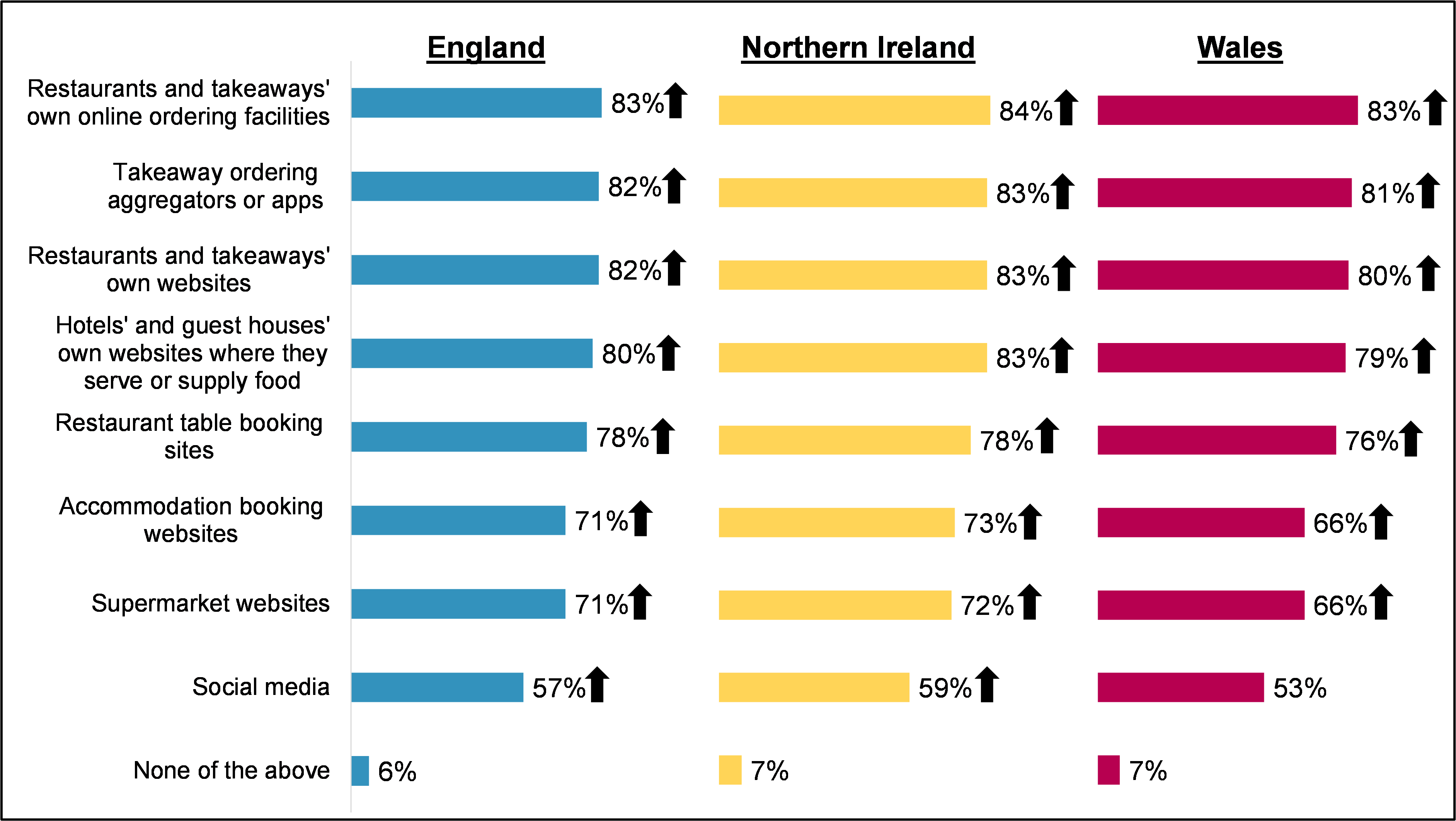
England: Restaurants and takeaways' own online ordering facilities 83%, Takeaway ordering aggregators or apps 82%, Restaurants and takeaways' own websites 82%, Hotels' and guest houses' own websites where they serve or supply food 80%, Restaurant table booking sites 78%, Accommodation booking websites 71%, Supermarket websites 71%, Social media 57%, None of the above 6%. Northern Ireland: Restaurants and takeaways' own online ordering facilities 84%, Takeaway ordering aggregators or apps 83%, Restaurants and takeaways' own websites 83%, Hotels' and guest houses' own websites where they serve or supply food 83%, Restaurant table booking sites 78%, Accommodation booking websites 73%, Supermarket websites 72%, Social media 59%, None of the above 7%. Wales: Restaurants and takeaways' own online ordering facilities 83%, Takeaway ordering aggregators or apps 81%, Restaurants and takeaways' own websites 80%, Hotels' and guest houses' own websites where they serve or supply food 79%, Restaurant table booking sites 76%, Accommodation booking websites 66%, Supermarket websites 66%, Social media 53%, None of the above 7%.
C13. Which, if any, of the following online facilities do you think should be required by law to display Food Hygiene Ratings? Base: FBOs that have FHRS (England: 465; Northern Ireland: 487; Wales: 478). ↑ Denotes a significant increase from 2021.
Businesses that supported mandatory online display typically also supported display at physical premises and considered an extension of existing regulations to online platforms as a logical progression. Some commented that mandatory online display would benefit customers by providing them with information to inform purchasing decisions, while others said that it would be beneficial to their business as it would promote their high standards. Some, while supportive of the concept, said that they were already displaying their rating on their online platforms and so did not think making it compulsory would affect them or their customers.
“I agree. If you’re going to have to have it physically on your front door then in the online world a business's website or online presence is like a virtual front door, so in the same way businesses should have to put it on their virtual front door.”
Takeaways and sandwich shops, England, FHRS rating of 5
“That wouldn't be a problem for us because we intend to maintain our five-star rating and we are proud to display that anywhere we can.”
Restaurants and catering, Wales, FHRS rating of 5
“It makes customers notice and be aware that we're a clean and tidy and maintain a high standard of cleanliness.”
Restaurants and catering, Northern Ireland, FHRS rating of 5
The minority of businesses that were not supportive of mandatory online display often had concerns about the cost and complexity of implementing this change to their websites, social media platforms and other online platforms. Others took issue with mandatory online display because of reservations about the efficacy and fairness of the FHRS.
“To be honest I wouldn't support that … administratively it’s quite costly to pay someone to update everything and I don't think it is viable in the current climate to expose further costs.”
Restaurants and catering, Northern Ireland, FHRS rating of 3
“I wouldn't like it. The reason being that the whole rating is an indicator of that day, not a long-term trend. By putting it there it can harm businesses. Whilst good for people with a good rating, that may lapse. Other places with a poor rating may step it up really quickly but this wouldn't be reflected if they don't go through the process of appealing straight away.”
Restaurants and catering, England, FHRS rating of 3
-
It should be noted that the survey sample did not include online only food businesses.
-
Online platforms businesses were probed with were: restaurants and takeaways' own online ordering facilities; takeaway ordering aggregators or apps; hotels' and guest houses' own websites where they serve or supply food; restaurants and takeaways' own websites; restaurant table booking sites; supermarket websites; accommodation booking websites; and social media.
Revision log
Published: 29 June 2023
Last updated: 5 July 2024